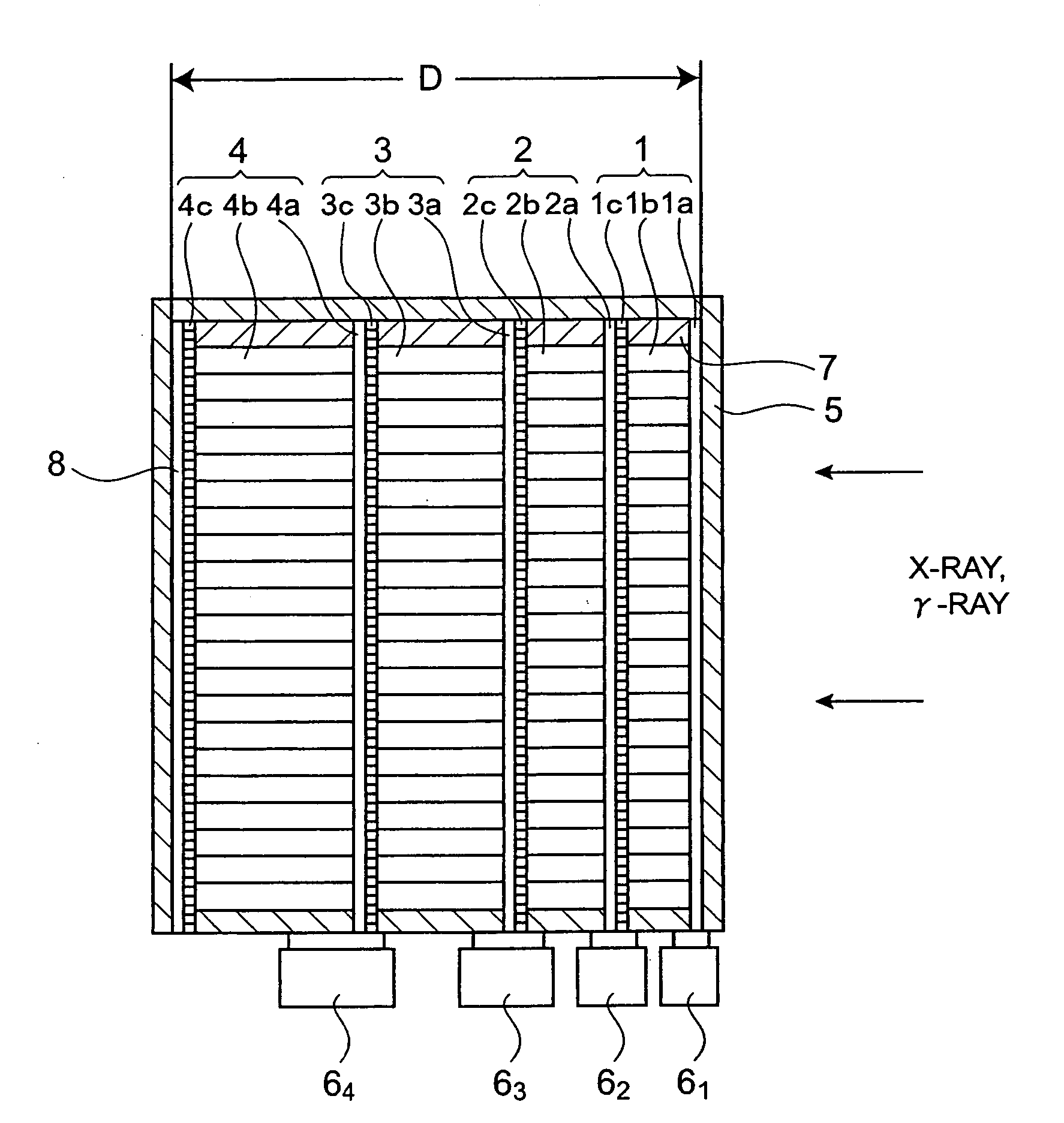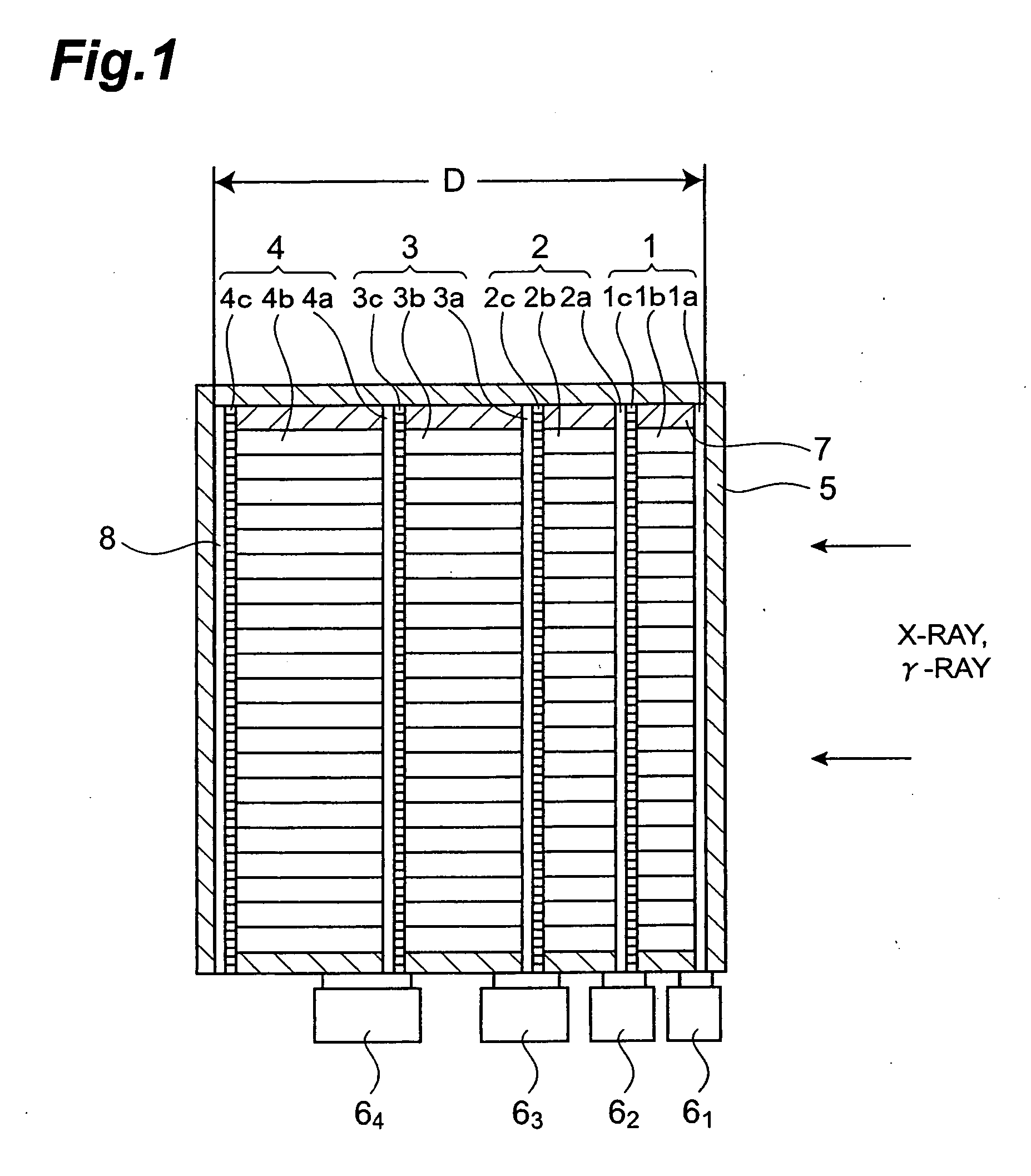Scintillator panel, scintillator panel laminate, radiation image sensor using the same, and radiation energy discriminator
a scintillator and scintillator technology, applied in the direction of fluorescence/phosphorescence, radiation controlled devices, optical radiation measurement, etc., can solve the problems of inability to say high detection precision, complicated procedures for obtaining incidence energy, and inherently limited thickness of scintillator, etc., to achieve high deliquescence properties, prevent obstruction of x-rays and other radiation incidents, and high strength
- Summary
- Abstract
- Description
- Claims
- Application Information
AI Technical Summary
Benefits of technology
Problems solved by technology
Method used
Image
Examples
first embodiment
[0038]FIG. 1 shows the present invention, which is a radiation energy discriminator using a scintillator panel.
[0039] In FIG. 1, the energy discriminator comprises four panels 1, 2, 3, and 4 (having scintillator 1b, 2b, 3b, and 4b, respectively), which receive radiation, a protective film 5, which covers entire panels 1, 2, 3, and 4, respectively, to prevent absorbing moisture by the scintillator 1b, 2b, 3b, and 4b, solid linear sensors or other photodetectors 61, 62, 63, and 64, which are respectively connected to end portions at one side of substrates 1a, 2a, 3a, and 4a for crystal deposition in the panels 1, 2, 3, and 4 and respectively detect the light emitted from the scintillator 1b, 2b, 3b, and 4b upon incidence of radiation, and supporting films 7, which are disposed at the end portions at the other side of the substrates 1a, 2a, 3a, and 4a for crystal deposition to support side face portions of the scintillator 1b, 2b, 3b, and 4b.
[0040] The panels 1, 2, 3, and 4 have a com...
second embodiment
[0059]FIG. 2 shows the present invention and is a sectional view of a radiation image sensor that uses scintillator panel of the present invention. The image sensor comprises five panels 21, 22, 23, 24, and 25 (respectively having scintillator 21b, 22b, 23b, 24b, and 25b which convert radiation to visible light) onto which radiation enters, a protective film 26, which covers the entire panels 21, 22, 23, 24, and 25 to prevent moisture absorption by the scintillator 21b, 22b, 23b, 24b, and 25b, photoelectric converters 27, comprising of photomultiplier tubes connected to end portions at one side of the substrates 21a, 22a, 23a, 24a, and 25a for crystal deposition inside the panels 21, 22, 23, 24, and 25 and obtain electrical signals by detecting the respective emitted light generated in the scintillator 21b, 22b, 23b, 24b, and 25b upon radiation incidence, and supporting films 28, disposed at the end portions at the other side of the substrates 21a, 22a, 23a, 24a, and 25a for crystal...
third embodiment
[0069] Also, in the case where the scintillator panel according to the present invention is used in an image sensor, a CCD or other image pickup element may be used without the use of photoelectric converters that comprise photomultiplier tubes, etc. To describe an example using an image pickup element with reference to a third embodiment, illustrated in FIG. 3, the same scintillator panel as that shown in FIG. 2 is used, and a CCD 30 is mounted to end portions at one side of the respective substrates 21b to 25b for crystal deposition of the panels 21 to 25 of this scintillator panel. With this embodiment, an image is formed not upon conversion of light to electrons by photomultiplier tubes or other photoelectric converters but the light that arrives upon propagating through the substrates 21b to 25b for crystal deposition can be picked up as they are by the CCD camera.
PUM
 Login to View More
Login to View More Abstract
Description
Claims
Application Information
 Login to View More
Login to View More - R&D
- Intellectual Property
- Life Sciences
- Materials
- Tech Scout
- Unparalleled Data Quality
- Higher Quality Content
- 60% Fewer Hallucinations
Browse by: Latest US Patents, China's latest patents, Technical Efficacy Thesaurus, Application Domain, Technology Topic, Popular Technical Reports.
© 2025 PatSnap. All rights reserved.Legal|Privacy policy|Modern Slavery Act Transparency Statement|Sitemap|About US| Contact US: help@patsnap.com



